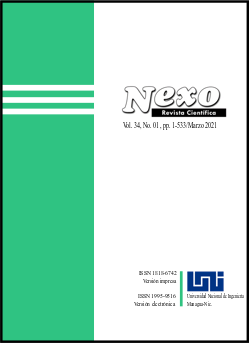An assessment of the quality of houses and households in sitio Lawesbra, Lapasan Cagayan de oro city: an extension program, Mindanao, Philippines
DOI:
https://doi.org/10.5377/nexo.v34i01.11294Keywords:
Houses, Household, Electrical, Plumbing, Civil Engineering, Risk Reduction MechanismAbstract
The study focuses on assessing the quality of houses and households in Sitio Lawesbra, Lapasan Cagayan de Oro City. The respondents of the study are composed of 899 households of 110 houses. The study utilized a descriptive research design. Descriptive statistics such as frequency count, percentages, and weighted mean were used to describe the houses and household in Sitio Lawesbra; The study found out that most households per house are 9. The average age is from 19-24. The majority of the dwellers are male. The majority of the household in Lawesbra are students. And there are dwellers who are employed. The majority of the household in Sitio Lawesbra have the following electrical standards. The majority of them have primary connections and are using circuit breakers in the panel board. The majority of the junction box is opened, with 3-4 splices per junction Box. The majority of the size of wires used in Sitio Lawesbra are not standard. But the majority are using the standard, convenient outlet. The majority of the households are not using octopus type of extension wire. The houses in Sitio Lawesbra have a primary water connection. The majority are using Polyvinyl chloride pipes and do not have leaks with the pipes or water system. The data further shows that the drainage system in Sitio Lawesbra is open. In terms of toilet systems, the majority have a standard size of a comfort room, made from concrete materials with ventilation. The majority of the dwellers are using pail flush type of toilet bowl, none are using automatic flush type, and however, four percent have an Antipolo type of toilet bowl. Seventy percent of the ground is concrete with its own septic tanks. The majority have substandard room and substandard kitchen ventilation. In addition, the majority have standard security windows, standard walling, and standard partition. The majority used wood for the ceiling and used Galvanized Iron for roofing. However, twenty-nine percent of the houses in Sitio Lawesbra have roof leaks. Finally, the majority in terms of risk reduction mechanism of the houses in Sitio Lawesbra have a sub-standard fire exit. In fact, nineteen percent do not have a fire exit, and only fifteen percent have a standard fire exit. In terms of door positioning, the path majority is sub-standard. However, sixty-three percent did consider that they have an evacuation area, though sub-standard. But thirty-seven percent claimed that they don’t have an evacuation area. Thus, based on the results, the following recommendations were implemented and recommended. The researchers already coordinated with the following agencies, and actions were made respectively. The local government improved drainage and pathway systems. CEPALCO installed the installation of primary electrical connections and an independent transformer with the light post. Cagayan de Oro Water District also implemented reevaluation and repair of the water connection upon recommendation. Thus, it is recommended that the University of Science and Technology of Southern Philippines improve Sitio Lawesbra, as the closest community to the university that needs further augmentation and extension.
Downloads
3050
Downloads
Published
How to Cite
Issue
Section
License
The authors who publish in Nexo Scientific Journal agree to the following terms:
- Authors retain the copyright and grant the journal the right of the first publication under the license Creative Commons Attribution License, which allows others to share the work with a recognition of the authorship of the work and the initial publication in Nexo Scientific Journal.
- Authors may separately establish additional agreements for the non-exclusive distribution of the version of the work published in the journal (for example, in an institutional repository or a book), with the recognition of the initial publication in Nexo Scientific Journal.
- Authors are allowed and encouraged to disseminate their works electronically (for example, in institutional repositories or in their own website) before and during the submission process, as it can lead to productive exchanges, as well as earlier and greater citation of published works.










